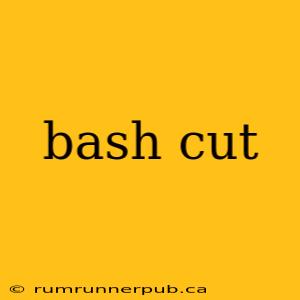The cut command in Bash is a powerful tool for extracting sections from each line of files. Whether you need to pull specific columns from a CSV file, extract substrings based on character positions, or manipulate text in various ways, cut offers a flexible and efficient solution. This article will delve into the intricacies of cut, drawing upon insights from Stack Overflow to provide a comprehensive understanding.
Understanding the Basics: cut Syntax and Options
The basic syntax of cut is straightforward:
cut [OPTIONS] [FILE]
The key options are:
-
-d DELIMITER: Specifies the delimiter used to separate fields. Defaults to tab (\t). This is crucial for working with data containing separators other than tabs, such as commas in CSV files. -
-f FIELDS: Specifies which fields to extract. Fields are numbered starting from 1. You can specify a range (e.g.,1-3), multiple fields separated by commas (e.g.,1,3,5), or a combination. -
-c CHARACTERS: Specifies which characters to extract based on their position within the line. Similar to-f, you can use ranges and commas.
Let's illustrate with some examples. Suppose we have a file named data.txt containing:
Name,Age,City
Alice,30,New York
Bob,25,London
Charlie,35,Paris
Example 1: Extracting the "Name" column (using comma as delimiter):
cut -d ',' -f 1 data.txt
This will output:
Name
Alice
Bob
Charlie
This directly addresses a common Stack Overflow question about extracting specific columns from comma-separated files. Many users struggle with the correct delimiter specification; using -d ',' is vital here. (Note: Error handling, like checking if the file exists, would be good practice in a real-world script).
Example 2: Extracting "Age" and "City" columns:
cut -d ',' -f 2-3 data.txt
Output:
Age,City
30,New York
25,London
35,Paris
Example 3: Extracting characters using -c:
Let's say we have a file names.txt with names:
Alice Smith
Bob Johnson
Charlie Brown
To extract the first 5 characters:
cut -c 1-5 names.txt
Output:
Alice
Bob J
Charl
This demonstrates the flexibility of -c, useful for extracting substrings based on position, which is a frequent topic on Stack Overflow relating to text manipulation.
Advanced Usage and Stack Overflow Insights
Many Stack Overflow questions revolve around handling complex scenarios. Let's consider some:
Handling Multiple Delimiters: While cut doesn't directly support multiple delimiters in one command, workarounds involve using other tools like awk or sed in conjunction. This is a common theme in Stack Overflow discussions about data manipulation.
Dealing with Whitespace: If your data uses spaces or tabs as delimiters, carefully consider whether -d is necessary (it defaults to tab), and understand that variable whitespace might require more sophisticated tools like awk to handle reliably. A user's question on accurately splitting lines with inconsistent spacing underscores this point.
Beyond the Basics: Practical Applications
cut's utility extends beyond simple column extraction. Consider these use cases:
- Log file parsing: Extract relevant information from log files based on timestamps or error codes.
- Data cleaning: Remove unwanted characters or portions of text from a dataset.
- Text processing in shell scripts:
cutintegrates seamlessly into shell scripts for automated text manipulation.
Conclusion
The Bash cut command is a versatile tool for extracting sections of text. Understanding its options and limitations, as highlighted by common Stack Overflow questions, is crucial for efficient data processing. By combining cut with other command-line tools, you can tackle complex text manipulation tasks effectively. Remember to always check for file existence and handle potential errors for robust scripting.
